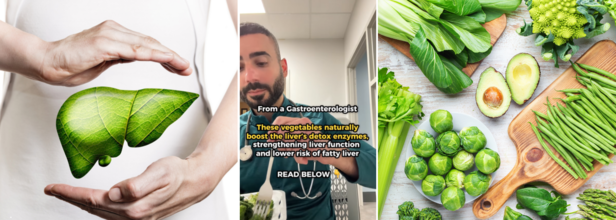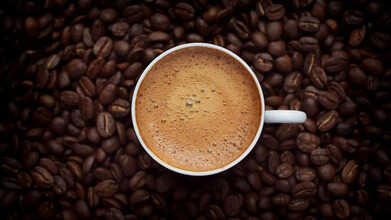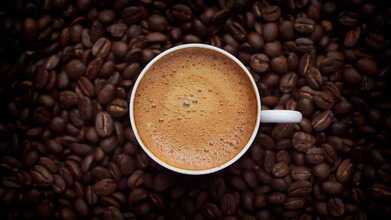- Health Conditions A-Z
- Health & Wellness
- Nutrition
- Fitness
- Health News
- Ayurveda
- Videos
- Medicine A-Z
- Parenting
Doctor Debunks Liver Detox Myths, Recommends These 14 Veggies Instead

Credits: Canva
Detox this, detox that, we have all heard a lot about it. Not so new, but still trending everywhere is the liver detox. But, does it really work?
As per John Hopkins Medicine, there is no scientific proof of liver detox drinks, which have flooded the market. Tinsay Woreta, MD, and a John Hopkins hepatologist debunks the myth that liver cleanses are important for daily health maintenance and are especially helpful after you have overindulged.
While some common ingredients in liver cleanses have been shown to have positive results — milk thistle has been shown to decrease liver inflammation, and turmeric extract has been shown to protect against liver injury — there have not been adequate clinical trial data in humans to recommend the routine use of these natural compounds for prevention, noted the John Hopkins Medicine website.
To second this, a Florida-based gastroenterologist, Dr Joseph Salhab also shared a post on his Instagram that stressed on the fact that 'you don't need a liver detox or cleanse'. However, his post claimed that you can boost your liber function naturally by eating vegetables.
14 Vegetables For Your Liver
Dr Salhab shared a list of 14 vegetables that would lower the risk of fatty liver disease and boost liver function.
"From a gastroenterologist: These vegetables naturally boost the liver's detox enzymes, strengthening liver function and lowering the risk of fatty liver," he wrote on his Instagram post.
- Broccoli
- Broccoli sprouts (highest sulforaphane content of all)
- Brussels sprouts
- Kale
- Cabbage (green, savoy, Napa, etc.)
- Bok choy
- Collard greens
- Mustard greens
- Turnip greens
- Swiss chard (contains other detox compounds, though lower in sulforaphane)
- Arugula
- Watercress
- Rapini (broccoli rabe)
- Cauliflower (not green, but still cruciferous and detox-active)
How Do These Vegetables Work?
“Your liver already detoxifies your body, and good nutrition helps it work at its best. It’s because they’re high in compounds like sulforaphane, which help induce Phase II enzymes (example: glutathione S-transferases, UDP-glucuronosyltransferases),” explained the doctor. As per him, these vegetables naturally boost Phase II detox enzymes that are already present in your liver.
As per the National Cancer Institute, US, Phase II detoxification is the process in which the liver uses one of two major enzyme pathways to change a toxic substance, such as an anticancer drug, into a less toxic substance that is easier for the body to excrete. In phase II detoxification, liver cells add a substance (such as cysteine, glycine, or a sulfur molecule) to a toxic chemical or drug, to make it less harmful.
Punjab Worst Hit By High Uranium Levels In India’s Groundwater; Raise Health Concerns

Credits: iStock
The latest Annual Ground Water Quality Report 2025 by the Central Ground Water Board (CGWB) has delivered a worrying revelation: Punjab now records the highest intensity of uranium contamination ever reported in India, with 62.5% of groundwater samples exceeding the safe limit post-monsoon. This is followed by Haryana, Delhi, Karnataka and Uttar Pradesh, indicating a dangerous pattern across north and north-central India.
While nitrate and fluoride remain more widespread contaminants, uranium’s increasing presence raises an urgent public health concern because even low-dose, long-term exposure can quietly harm vital organs.
Where Is Uranium Contamination Rising?
The CGWB tested 3,754 groundwater samples across India in pre- and post-monsoon seasons. The findings show a clear upward trend:
Nationally, uranium exceedance rose from 6.71% (pre-monsoon) to 7.91% (post-monsoon).
Punjab recorded the highest contamination:
- 53.04% pre-monsoon
- 62.50% post-monsoon
Haryana followed with 15–23.75% of samples above limits.
- Delhi: 13–15.66%
- Karnataka: 6–8%
- Uttar Pradesh: 5–6%
The report highlights northwestern India: Punjab, Haryana, Delhi, and parts of Rajasthan and Uttar Pradesh — as the main hotspot, likely due to geogenic factors, aquifer depletion, and intense groundwater extraction. Meanwhile, eastern and southern states reported minimal contamination.
Why Uranium in Water Is Dangerous
According to the 2025 study “Uranium’s hazardous effects on humans and recent developments in treatment,” the real threat from uranium lies in its chemical toxicity, not its radioactivity.
Kidney Damage: The Most Significant Risk
Uranium behaves like a heavy metal that gets absorbed and stored in the kidneys, impairing their ability to filter waste.
This can lead to:
- Proteinuria (excess protein in urine)
- Reduced kidney function
- Long-term kidney diseases
Even low-dose, chronic exposure through drinking water can gradually weaken renal functioning.
Respiratory Harm and Lung Cancer Risk
People who inhale uranium particles — especially workers in mining or processing — face:
- Chronic respiratory irritation
- Persistent coughing
- Higher risk of lung cancer, particularly due to radon gas produced as uranium decays
Gastrointestinal Entry and Toxic Build-Up
Recent findings note that the gastrointestinal system is the main route of uranium entry. Once consumed through contaminated water, uranium moves from the stomach and intestines into soft tissues and organs.
Bone Accumulation and Cancer Risk
Because uranium is a chemical analog of calcium, it can get deposited into bones. Over time, this raises the risk of bone cancer and may interfere with normal bone cell functioning.
Possible Reproductive and Developmental Effects
Animal studies suggest:
- Potential risks of congenital disabilities
- Effects on reproductive organs
- But direct evidence in humans remains incomplete, calling for more research.
Neurological and Immune Effects Being Explored
Some studies hint at:
- Behavioral changes
- Cognitive deficits
- Unclear impacts on the immune system
These areas remain under-studied but concerning.
Why India Must Worry Now
The CGWB report warns that while most groundwater in India remains safe, the pockets of rising uranium contamination require immediate monitoring and mitigation. With millions relying on groundwater for daily consumption, even a small rise in toxic metals can translate into widespread health damage over time.
Long-term exposure rarely shows immediate symptoms, which makes the threat quiet but deeply harmful.
Daily Coffee Consumption May Slow Biological Aging by Five Years, Experts Suggest

Credits: Canva
A new study suggests that drinking coffee could help certain individuals slow their biological ageing. Researchers found that consuming up to four cups a day may give some people a biological advantage, effectively making their cells appear five years younger than those who abstain. The study, published in BMJ Mental Health, focused on people with severe mental illnesses, including schizophrenia, bipolar disorder, and psychosis.
How Coffee Might Affect Ageing
The scientists linked this effect to coffee’s high antioxidant content, which appears to protect and lengthen telomeres—the protective caps at the ends of chromosomes. Telomeres function like the plastic tips on shoelaces, preventing chromosomes from fraying. Normally, telomeres shorten naturally as we age, but in people with major psychiatric conditions, this process is often accelerated, contributing to premature cellular ageing.
According to News Medical, coffee’s antioxidants can reduce oxidative stress, a factor that speeds up telomere shortening and biological ageing. By consuming the optimal amount, individuals may slow this process, potentially gaining the equivalent of five years of cellular youth.
The Study: Coffee, Mental Health, and Telomeres
The study observed 436 adults, including 259 participants with schizophrenia and the remainder with affective disorders like bipolar disorder or major depressive disorder with psychotic features. Researchers analyzed participants’ coffee consumption and its impact on telomere length.
Results showed that drinking up to four cups daily was associated with longer telomeres. However, consuming more than five cups each day did not provide additional benefits; in fact, heavy coffee drinkers were biologically older compared to those consuming one or two cups. This highlights the importance of moderation, as excessive caffeine intake may lead to cellular stress and telomere shortening.
The study authors emphasized that while this research cannot definitively prove causation—because it was observational—coffee’s established health benefits make it a plausible contributor to preserving cellular health. As they noted: “Telomeres are highly sensitive to both oxidative stress and inflammation, further highlighting how coffee intake could help maintain cellular integrity in a population predisposed to accelerated ageing.”
Guidelines and Considerations
Global health authorities generally recommend limiting caffeine intake to around 400 mg per day, roughly equivalent to four cups of coffee. Staying within this range seems to provide the protective effects without overloading the body.
The researchers also acknowledged some limitations in the study. They did not track other sources of caffeine participants may have consumed, nor did they account for the type of coffee or the time of day it was consumed, factors that could influence outcomes.
Overall, the study reinforces the idea that moderate coffee consumption can be a simple lifestyle choice with potential long-term benefits for mental health populations and, possibly, the general population as well.
Can Your Morning Coffee Raise Your Blood Pressure? Cardiologist Weighs In

Credits: Canva
Americans reach for coffee more often than any other drink, and studies continue to show that a couple of daily cups suit most people and may even support overall health. At the same time, nearly half of U.S. adults live with high blood pressure, defined as a systolic reading above 130 mmHg or a diastolic reading above 80 mmHg.
This raises a natural question. Does caffeine play a part in rising blood pressure levels? Is our strong preference for coffee adding to the problem, or could regular coffee intake possibly help keep blood pressure lower?
Coffee And High Blood Pressure: Is There A Link?
Many people enjoy coffee because it sharpens focus and lifts energy. That same stimulating action is also what can nudge blood pressure upward for a short while. John Higgins, MD, a cardiologist and professor of medicine at UTHealth Houston, agrees that this happens and notes that the general answer is yes. Moderate coffee use is usually acceptable for people whose blood pressure is stable or only slightly raised, though individuals react differently. While caffeine can push readings higher for a brief period, long-term drinking patterns tell another story.
Several studies report no added risk of hypertension among people who drink coffee often. A review of 13 cohort studies found no clear link between coffee intake and the development of high blood pressure. A separate 2023 review even noted that heavier coffee consumption was tied to a 7 percent lower risk of hypertension. The evidence suggests that people who drink coffee regularly tend to build tolerance to caffeine’s short-lived effect on blood pressure.
The 2025 AHA/ACC Hypertension Guideline does not list specific limits for coffee, and the American Heart Association states that moderate amounts appear fine for healthy adults.
How Much Coffee Is Safe To Consume For Blood Pressure Patients?
There is no set rule, but research supports one to three cups a day for most people whose blood pressure is well controlled.
Remember that caffeine levels can vary quite a bit depending on the brewing method, and it is wise to think about your total caffeine intake, including tea, soft drinks, and energy drinks.
Keep the following points in mind when having coffee:
- Choose your add-ins carefully. Sugar, flavored syrups, and full-fat milk can lead to weight gain and metabolic issues, both of which raise blood pressure risk and may add to caffeine’s influence.
- Avoid drinking coffee late in the afternoon. Coffee taken after two or three o’clock can disturb sleep, and poor sleep on its own can worsen blood pressure.
- Allow some time before checking your blood pressure. Coffee can cause a temporary rise, giving you an inaccurate reading. If you want to see how caffeine affects you, measure your pressure before drinking and again 30 to 60 minutes later.
Who Should Avoid Drinking Coffee?
Drinking coffee is generally safe for those with steady or slightly raised blood pressure, and the greater concern usually lies with uncontrolled hypertension. Still, people who are sensitive to caffeine or have poorly managed blood pressure should be more careful.
Extra caution is advised if you have:
- Uncontrolled stage 2 or 3 hypertension
- Organ damage tied to long-standing high blood pressure or other chronic illnesses
- Heart rhythm problems, particularly atrial fibrillation
- Conditions such as hypertrophic cardiomyopathy
In these situations, consider limiting or avoiding caffeinated coffee until your readings improve. Keep in mind that coffee is only one part of overall blood pressure care. Do not overlook reducing sodium intake, staying active, managing weight, and following prescribed treatment.
© 2024 Bennett, Coleman & Company Limited

